August 17th
Conferences
THE MONASTERY OF TULEBRAS
Of Arts and Devotions: Artistic Projects in the Monastery during the Modern Age
Mª Josefa Tarifa Castilla
University of Zaragoza
The monastery of Nuestra Señora de la Caridad was the first foundation that the female Cistercian monastery made in the Iberian Peninsula, at the request of the monarch García Ramírez, with the arrival of nuns from the monastery of Lumen Dei in Favars (France) to the Navarrese town of Tudela (1147). A few years later, in 1157, they settled definitively in Tulebras, a small village on the banks of the river Queiles, where monastic life has developed uninterruptedly up to the present day.
The construction of the medieval monastery was undertaken from agreement to the usual outline followed among the Cistercians, with the abbey church on one side, to which was attached a central cloister around which were articulated the different rooms of the house necessary for the good development of the monastic life, such as the conference room capitular, the refectory, the kitchen or the dormitory, allowing the nuns to live humbly and soberly inside the monastery of agreement to the maxim of the Rule of St. Benedict of ora et labora.
The strong religious and material crisis that the monastery experienced in the 14th and 15th centuries was followed by an economic, spiritual and artistic renaissance with the arrival of the 16th century, which allowed new works to be carried out, many of them financed by the nuns' relatives, most of whom belonged to important Navarrese lineages. At the beginning of the 16th century, the community was governed by the abbess Ana de Beaumont (1506-1524), daughter of the lords of Monteagudo, under whose mandate the roof of the existing cloister was reformed in the 1520s, with simple ribbed vaults, which are still visible today, in which the master builder Francisco el Darocano worked. Under the rule of María de Beaumont (1524-1547) the monastery fence was renovated thanks to the donation of 500 old ducats made in 1530 by her father, Luis III de Beaumont, Count of Lerín and Constable of the kingdom. During this period, an exceptional altarpiece of painted panels dedicated to St. John the Baptist, from the first third of the 16th century, also arrived at the monastery, which was bequest by Guillaume de Beaumont, lord of Monteagudo, as indicated by the coat of arms painted on the masonry of the altarpiece. A work that is an example A of the first manifestations of Renaissance painting in Navarre, and is currently in the Museum of Navarre.
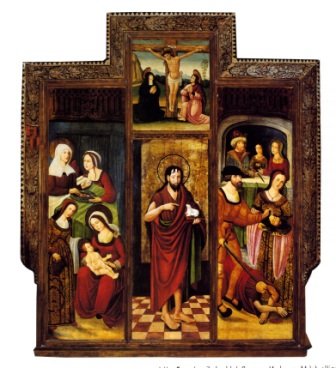
Altarpiece of St. John the Baptist, c. 1530, now in the Museum of Navarre.
In the middle of the 16th century the monastery underwent one of the most important renovations in its construction, the renovation of the roof of the church, since the original stone pointed barrel vault had collapsed, and the abbey church was protected with a wooden roof provisional . Abbess María de Beaumont y Navarra (1557-1549) obtained from the general visitor of the Cistercian Order in Aragón and Navarra, Archbishop Hernando de Aragón y Gurrea (1539-1575†), the money necessary to turn the roof over again, 500 Jaquesan pounds, with which the exceptional starred ribbed vaults were undertaken, which today can be seen in the interior of the church, with the coat of arms of the generous patron who made them possible hanging from the central polychrome wood core topic . The covering of the four bays of the nave, beginning with the space at the foot, was followed by the completion of the remodeling of the roof, with the last bay of the nave and the chancel, which was contracted in 1563 by the workman from Tudela, Pedro de Verges, works that were also financed by the Aragonese prelate, under the mandate of the abbess Ana Paquier de Eguaras (1559-1573), belonging to the lineage of the lords of Barillas. Between 1563 and 1565, Verges also undertook the construction of the new conference room chapter house, also covered by starred vaults, which has not survived to the present day, as well as the sacristy, the confessional, the chapel of San Bernardo and the choir loft of the church, for which later, in 1589, the Tudela sculptor Bernal de Gabadi made thirty oak choir stalls.
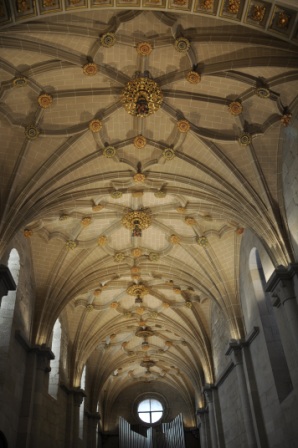
Stellated ribbed vaults of the abbey church, from the middle of the 16th century, with the coat of arms of Archbishop Hernando de Aragón. Photo: M. J. Tarifa
The appearance of the interior of the temple was completed with a new Renaissance altarpiece that presided over the main altar, dedicated to the Dormition of the Virgin, patroness of the monastery, one of the great jewels from the artistic point of view that the monastery possesses, and that since the end of the 20th century has been exhibited in the museum that the nuns set up. A work dated between the years 1565-1570, made by Jerónimo Vicente Vallejo Cosida, an Aragonese painter who executed the main pictorial commissions of Don Hernando de Aragón, besides being his artistic advisor, so that undoubtedly the presence of this altarpiece in the monastery has to do with the mediation of the archbishop. A piece that iconographically is formed by the oil tables of the Santos Juanes and the Calvary on the bench, María Magdalena, Tránsito de la Virgen and San Nicolás in the main body and the trifacial Trinity in the attic, as analyzed in detail by professor Jesús Criado Mainar in one of the conferences of the cycle dedicated to the monastery last year 2014.
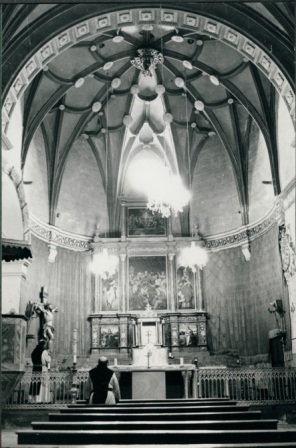
View of the chevet of the church with the Renaissance altarpiece by Jerónimo Vicente Vallejo Cosida, prior to the 1970 renovation.
With the arrival of the 17th century, new reforms were undertaken in the building, such as the cloister with individual rooms, in which the masons Pascual de Horaa, a resident of Cascante, and Jerónimo de Baquedano, from Vera de Moncayo (Aragón) worked, and a sunny brick gallery. In the middle of the 18th century a large part of the monastery again threatened ruin, which forced the abbess Ana Humbelina Arenzana y Oñate to propose a profound renovation of the interior starting in 1765, which affected the abbey palace and the guest quarters, among other spaces, in which the masters José Asensio, José Marzal and Vicente Comuel intervened.
Also the chapel of San Bernardo, which had been erected in the mid-sixteenth century by Verges, underwent a profound remodeling in the eighteenth century, from agreement to the Baroque taste, being covered with a dome with lantern decorated with plasterwork of profuse vegetation. A dependency that was presided from the XVII century by the altarpiece dedicated to the Virgin with the Child comforting San Bernardo that donated in 1649 the nun Catalina Royo, although at the present time of the walls of the chapel two baroque canvases hang, one with the same topic of the Lactatio of San Bernardo of Madrid school, and another one of San Benito painted by the Cascantino Diego Díaz del Valle.
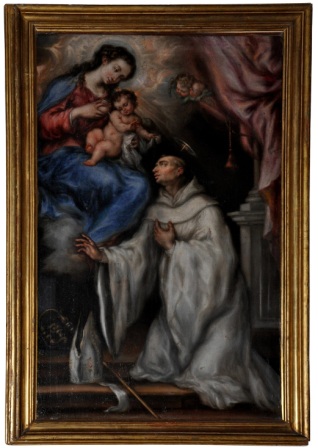
The Virgin and Child comforting St. Bernard, second half of the XVII century. Photo: M.J. Tarifa
The cult to the Blessed Virgin Mary was also manifested through the different Marian devotions, as reflected in the altarpiece of Our Lady of the Rosary, from the mid-17th century, donated by the Oñate family, before which the nuns prayed the rosary in community, together with the representations of the Immaculate Conception, whose iconography was widely spread in the Baroque centuries, as exemplified by the paintings that today are exhibited in the halls of the museum. Of all of them, the one that had the greatest fervor in Tulebras, as much for the nuns as for the neighbors of the town, was the Virgin of the Bed, an image of dress of the XVII century that the nuns commissioned, arranged from 1784 in a wooden bed of rococo polychrome acquired together with six blandones, and that represents the sleep of the Virgin, in a placid dream, in the previous moments of ascent to the sky in body and soul. Still today the Assumption of the Virgin is the main local festivity, which is celebrated with the greatest solemnity in its festivity, on August 15, being taken out the image in procession through the streets of Tulebras, which is repeated on the 20th of the same month, when San Bernardo, patron saint of the town, is celebrated.
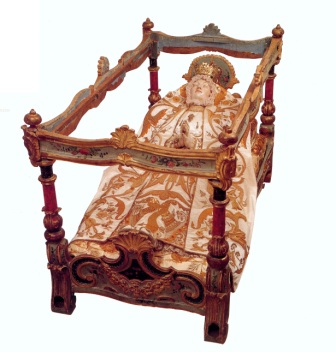
Virgin of the bed, XVII century
Furniture, 1784
